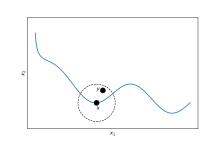The property of local nonsatiation of consumer preferences states that for any bundle of goods there is always another bundle of goods arbitrarily close that is preferred to it.[1]
Formally, if X is the consumption set, then for any and every , there exists a such that and is preferred to .
Several things to note are:
- Local nonsatiation is implied by monotonicity of preferences. However, as the converse is not true, local nonsatiation is a weaker condition.
- There is no requirement that the preferred bundle y contain more of any good – hence, some goods can be "bads" and preferences can be non-monotone.
- It rules out the extreme case where all goods are "bads", since the point x = 0 would then be a bliss point.
- Local nonsatiation can only occur either if the consumption set is unbounded or open (in other words, it is not compact) or if x is on a section of a bounded consumption set sufficiently far away from the ends. Near the ends of a bounded set, there would necessarily be a bliss point where local nonsatiation does not hold.
Notes
- ^ Microeconomic Theory, by A. Mas-Colell, et al. ISBN 0-19-507340-1
